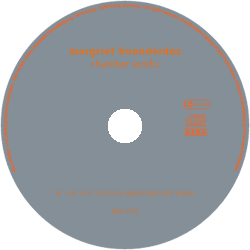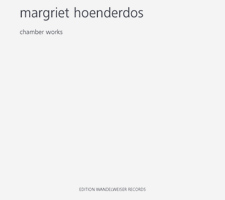EDITION WANDELWEISER RECORDS
> CD catalogue
>> Margriet Hoenderdos
_____________________________________________________________________
<< >>
margriet hoenderdos
chamber works
| order
reference:
medium: composer: performer: |
EWR
1506 CD Margriet Hoenderdos Fie Schouten (bass clarinet), Stefanie Liedtke (bassoon), Hilde Kaizer (clarinet), Joeri de Vente (horn), Anna Duinker (oboe) Quatuor Danel: Marc Danel, Gilles Millet (violin), Tony Nys (viola), Guy Danel (violoncello) with Peter Nys (viola), Godefroy Vujicic (violoncello) Margo Rens (soprano) |
 |
 |
>> thea derks >> the wire margriet hoenderdos (1952-2010) 01 de lussen van Faverey (1990) 02 maart ‘98 (1998)* audio sample>> 03 juli ‘06 (2006, text: Bas Geerts)* 01: Fie Schouten (bass clarinet), Stefanie Liedtke (bassoon), Hilde Kaizer (clarinet), Joeri de Vente (horn), Anna Duinker (oboe) 02: Quatuor Danel: Marc Danel, Gilles Millet (violin), Tony Nys (viola), Guy Danel (violoncello) with Peter Nys (viola), Godefroy Vujicic (violoncello) 03: Margo Rens (soprano) * live recordings Margriet Hoenderdos was born in 1952. She composed her first mature piece, blue time for two pianos, in 1981 while studying with Ton de Leeuw, and her last work, januari '10 for ensemble, in the year of her death. In between she wrote some fifty com- positions, ranging from solo works to orchestral pieces. Within Dutch music life with its preference for grand rhetorical gestures her highly refined work remained a background presence, but a powerful one, attracting a small but dedicated following of colleagues, musicians and listeners. Two works on this disc are related to poetry. juli '06 is based on the poem warwords by poet, painter and Hoenderdos' life partner, Bas Geerts. The woodwind quintet de lussen van Faverey ('Faverey's loops' or possibly 'Faverey's nooses') is Hoenderdos' response to the work of Hans Faverey, the great Dutch post-war poet, who wrote the title sequence of his final collection Het ontbrokene to be set to music by Hoenderdos. Instead of creating a conventional song cycle, she composed this instrumental work. In both cases, language and poetry have an uneasily hovering presence in the composition. Faverey's poetic logic is a determining background presence, though entirely submerged into instrumental musical form – in the score of de lussen van Faverey the com- poser writes: "The title refers to Faverey's ability to launch a lingual movement and 'pull it back' in the shorter or longer term, the way a boomerang or dolphin makes its curve, reprising it elegantly and returning, at times, with such power and accuracy that its point of departure is being passed in reverse." Geerts' poem is itself a spectral in-between of languages, a collage of belligerent phrases from George W. Bush's 2003 State of the Union, structured such that within them syllables are found which together com- prise a Latin fragment from Cicero on the rhetorical manipulation of word meanings. Thus the phonetically notated poem exists in an indeterminate space between languages; similarly, Hoenderdos' setting of it constantly hovers at the edge of comprehensibility, afloat at the threshold of language and sound. This hovering between categories is, I believe, vital for Hoenderdos' nuanced sense of form. She worked with rigorous numerical structures, using strong forms and sharply defined instrumental idioms, yet in spite of (or because of) this careful definition it's never quite possible to indicate when, where or how the music takes place. In any Hoenderdos composition, various layers of structure are calculated to unsettle one another, producing a music that sounds at the same time determined, unplaceable, meticulous, and very alive. The structure of presentation is like an affective clef, a basic framework that allows for the perception of the music, giving it a pre- sence and a basic character. The structure of presentation determines the listener's access to a piece, how you hear it, yet at the same time it determines very little about the music. In de lussen van Faverey this structure is simply the five times nine synchronized entries of the woodwind quintet, a polyphonic harmony beginning again and again but always petering out in changing ways. In juli '06 it is the rising tendency of the voice, line after line of the poem, that gives the music its affective quality of constantly mounting tension – perhaps befitting an atmosphere of rhetorical urgency. In maart '98 it is the nebulous sonic continuum that is comprised entirely of glissandi, performed individually by each performer without coordinating their timing, a landscape full of moti- ons, formed itself by those motions as they go. Though these very strong structures determine the surface quality of a work, they do so in such a basic way that they end up dis- appearing, shifting the listener's focus to their supplement: the sonic details, articulated through the gestural spaces of the pieces. Hoenderdos composes not so much explicit melodies and expressive gestures as gestural atoms moving within a precisely defined parametric space. Yet they always seem to overflow their space of definition. In maart '98 they are glissandi of varying speeds, using a set of eleven different types of bowing that implicitly determine everything about the timbre and quality of the gesture's motion, yielding a remarkable richness of color in the ensemble's infinite variety of shade combinations. juli '06 combines two ways of singing in every phrase: monosyllabic cantabile with various gradations of vibrato, and non-vibrato glissandi in which articulation proceeds variously by phrase, word, syllable or phoneme. The single syllables correspond to the Latin layer of Geerts' poem, but I do not advise trying to follow it on that level: to my ears, the song rather focuses on the way these different vocal types influence one another, and fuse into strange vocal gestalts. In the process, one may or may not pick up words or fragments of meaning in whichever language. In de lussen van Faverey, the gestures are repeated notes of varying lengths, tonal inflections and dynamic shapes, sometimes shifting in pitch. Here, the writing may feel more static, yet it always seems to be on the edge of burgeoning into melody. The gestures of each piece combine into constantly shifting musical objects. Hidden clockworks operate from the background cau- sing these transformations, and an impression arises of objects outside of time organized according to their own logic, like rotating higher-dimensional forms projected onto the plane of musical time. One senses gestures and vocal types shift and recombine in juli '06, and indeed, a glance at the score reveals a number of surprisingly simple isorhythmic processes at work, the straightfor- wardness of which is belied by the richness of the sounding results. The lines making up maart '98 have the atmosphere of coming to us from an exotic universe of elementary energy transmissions, rotating within the frame of actually audible musical form. In de lussen van Faverey, with each entry listeners may find themselves wondering whether or not they have heard a particular timbre, chord or combination before. As it is, some entries are strictly and regularly repeated, while in others particular voices find them- selves recombined and varied, giving the impression of mysterious sets of chords that transform and shift, unsettling the logic of time and memory and blurring the distinction between old and new. By their networks of structures these pieces create ambiguous labyrinths in which a striking music is hiding in plain sight. As you enter them by listening, I hope Hoenderdos' music will find you, and introduce you to its richly nuanced, ever changing universes. Samuel Vriezen
|